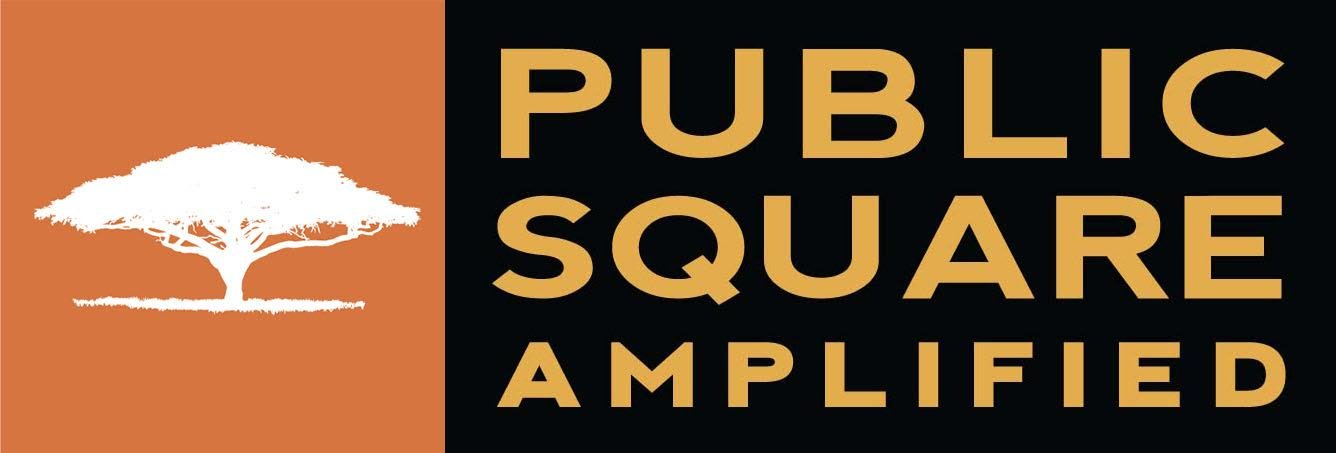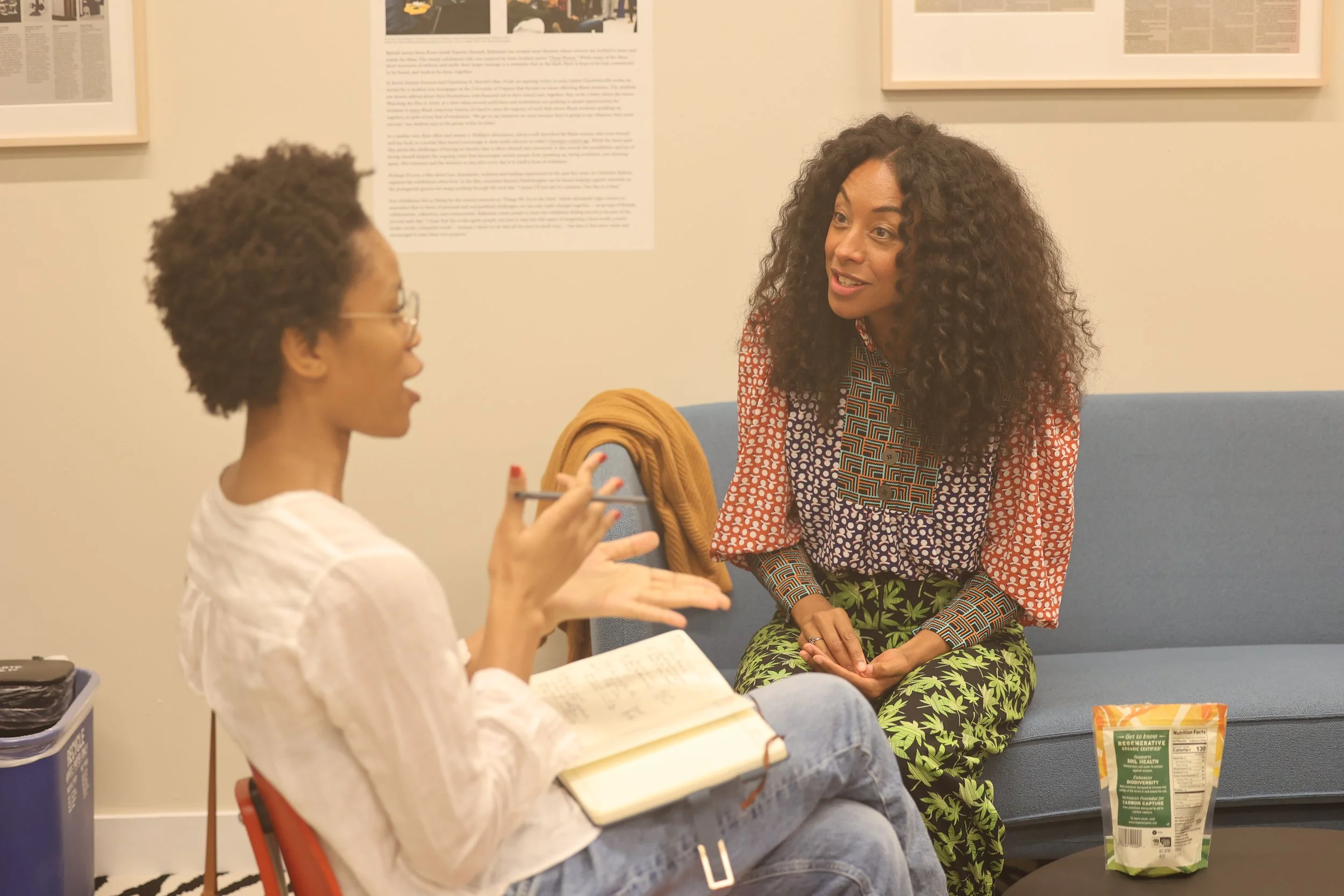Corinne Bailey Rae drops into Express Newark, and students are thrilled
After a Q&A and performance at Express Newark, British singer-songwriter Corinne Bailey Rae gives a pair of Rutgers students an impromptu electric guitar lesson on September 7, 2023. (Josie Gonsalves for Public Square Amplified)
NEWARK, NJ–Corinne Bailey Rae is a time traveler. A cosmonaut. A historian of the future past. And this benevolent explorer wants her fans to see what she has seen. Her latest album, Black Rainbows, a 45-minute transmission released September 15, invites the listener on an immersive, sonic voyage traversing the American South, Ethiopia, and the great expanse of outer space as Bailey Rae surveys what was and what will be of Black existence.
But how did she arrive at this liminal space? By looking backward.
The Grammy Award-winner’s time machine of choice was the Stony Island Arts Bank in Chicago’s South Side. Rescued and renovated by the multidisciplinary artist Theaster Gates, the Arts Bank is 17,000 square feet of space for innovation in contemporary art and archival practice. Between 2017 and 2020, the UK-dwelling Bailey Rae crossed the Atlantic numerous times to visit its extensive archival collections containing art, music, books, magazines, and “negrobilia” produced by, for, and about Black Americans.
When Bailey Rae illustrates how these inanimate artifacts, paradoxically “fizzing with life,” captivated her, it is easy to imagine a haunting. Yet, the eerie prospect of unsettled spirits seeking peace or causing trouble does not perturb the singer-songwriter. She fervently wants to “giv[e] voice to things that can’t talk.”
On Black Rainbows, she succeeds in this endeavor, working skillfully as a medium to create inhabited songs. The elegiac “Peach Velvet Sky,” and the seductive and playfully subversive “He Will Follow You With His Eyes,” are exemplary of this mystic ability. Drawing from Harriet Jacobs’ antebellum autobiography, Incidents in the Life of a Slave Girl, and mid-20th century beauty product adverts, Bailey Rae stages affecting vignettes of Black femininity and motherhood. The aforementioned tracks evoke particular forms of violence perpetrated against Black women in America: the psychological (colorism and featurism) and the physical (chattel slavery and sexual assault).
Memory is fraught political territory. Like the Arts Bank, this album is an active remembering, a rejection of the State’s project of forgetting. Bailey Rae perceives Black Rainbows “as a witness for stories that have been hidden, or silenced, or erased, or buried.” As the American right legislates the eclipsing of marginalized histories that countervail the dominant myths white America tells itself about itself, her decision to share this album with sites of learning is timely.
“The main thing I found when uncovering these stories is the question of ‘Why didn't I know these things earlier?’ Especially someone who's a student or someone who has an interest or pursuit in Black history,” Bailey Rae revealed, “I thought, ‘Why don’t I already know all of this stuff? Why didn’t I learn it in school?’ I really wanted to engage with organizations that were in teaching.”
Bailey Rae poses with Express Newark Co-Executive Director Salamishah Tillet, Rutgers professor Stefon Harris, RECORD HIGH Director Mark Conklin, Express Newark Co-Executive Director Nick Kline and Institute of Jazz Studies Executive Director Wayne Winborne on September 7, 2023. (Josie Gonsalves for Public Square Amplified)
On September 7, she visited Rutgers University-Newark, home of the Institute of Jazz Studies (IJS), the world’s most comprehensive jazz archive and research library. As an extension of their undergraduate class, Executive Director of the IJS (and PSA board member) Wayne Winborne and acclaimed jazz vibraphonist Stefon Harris have developed a lecture series, Jazz and the Art of Listening. Harris told PSA that Bailey Rae was the inaugural invitee because she is the “ultimate example of art,” a musician “using her gift to tell stories that are important to hear.”
Hosted at Express Newark, a third space bridging the local community and Rutgers’ campus while promoting socially engaged art, its co-executive directors Salamishah Tillet and Nick Kline were in attendance alongside nearly 100 Rutgers-Newark students. Mark Conklin joined the singer on stage to direct the Q&A. He oversees Prudential Center’s new program RECORD HIGH, which focuses on equipping Newark adolescents with the requisite tools for careers in music and entertainment.
Before performing two tracks from the then-unreleased album, Bailey Rae spoke to a hall filled with college students of color. Her face lit up with each question, and in the lift of her voice was the wide-eyed delight of the proverbial kid in a candy store.
A Night at the Museum
The following Sunday, at the National Jazz Museum in Harlem, she bewitched. Operating in the dark and strange beauty of the occult, she pulled on threads of Afro-futurism, magic, and religion. Inspired by Sun Ra and George Clinton’s P-Funk, the music is transcendental. A masterful live jazz performance, “dreams of the marvelous” played before the audience in full color; it was funky, silly, messy, and warped.
Without a raised platform, Bailey Rae and her band were level with the audience. There was no separation between concertgoer and performer. In the intimacy of a room so small it accommodated no more than 80 people, they chanted her lyrics; hung onto her storytelling; and felt the drummer Myke Wilson, saxophonist Aaron Burnett, flutist and background vocalist Melanie Charles, guitarist Kyle Bolden, and keyboardist and bassist Steve Brown. Bailey Rae’s voice roared, stretched, leaped, quieted, and she was resplendent. As each song quaked with life, a single question lay over the awe-struck crowd: How much power can an object hold?
Discovered amongst the Arts Bank’s collections, an ashtray molded in the image of an open-mouthed Black child inspired “Erasure,” a defiant rock stomp itemizing racism’s ravaging of Black youth from then until now. “Earthlings” follows, and Bailey Rae embodies the role of an otherworldly emissary fresh from the mothership, warning that Earth is inhospitable, especially for the oppressed. She beckons to another planet, another universe, to utopia, where we “could dig our/gardens and live.”
With “Put It Down,” the songstress-cum-extraterrestrial continued crooning and commanding, urging the audience to let go and “party like we’re lost in space.” So they did. Bailey Rae has seen the future, and there is nothing to worry about. Before converts join her in lift-off, they must offload the telluric. Liberating themselves won’t be easy: the weight of Earth’s oppressive systems falls most heavily on marginalized bodies. But transcendence has always required work.
An Artist Breaks Free
Community reporter Chelsea Egu interviews Bailey Rae about her new album, Black Rainbows. (Josie Gonsalves for Public Square Amplified)
Thanks to the early aughts success of her eponymous soul-inflected R&B début—in particular the hugely popular “Put Your Records On”—an image that endures of Bailey Rae, and her sound, is “the sunshine girl.” On subsequent albums, The Sea (2010) and The Heart Speaks in Whispers (2016), she wades in slightly darker waters. Her exciting, though tentative, experimentation with alternative sounds on the latter was necessary for her latest endeavor.
With only ten tracks, Black Rainbows is Bailey Rae’s most compact LP. It is also her most expansive and dynamic; a masterwork. She confidently engineers her songs and voice to fall apart and come back together. The deployment of jazz and punk perfectly facilitates this dis- and re-assembling. For the singer-songwriter, they are “two sides of the same [coin],” rule-breaking genres speaking freedom. She, too, is fearlessly breaking free from fan expectations and the conventions of commercial appeal.
It would be absurd to suggest that love is infantile terrain by characterizing Black Rainbows as a maturation (especially as Bailey Rae successfully retrods that familiar ground with the luscious “Red Horse”), but it is certainly a departure. Beyond the sunny glow of romance, the Grammy Award-winner is finally searching for other stars.
Black history is too rich, too complex, and “too interesting to me to then write an album of love songs,” she declared with a vigor that suggests this project is only the beginning. In breaking from the personal, Corinne Bailey Rae has found the radical power of the communal. With her, she wants listeners to dance, worship, and even fly.



